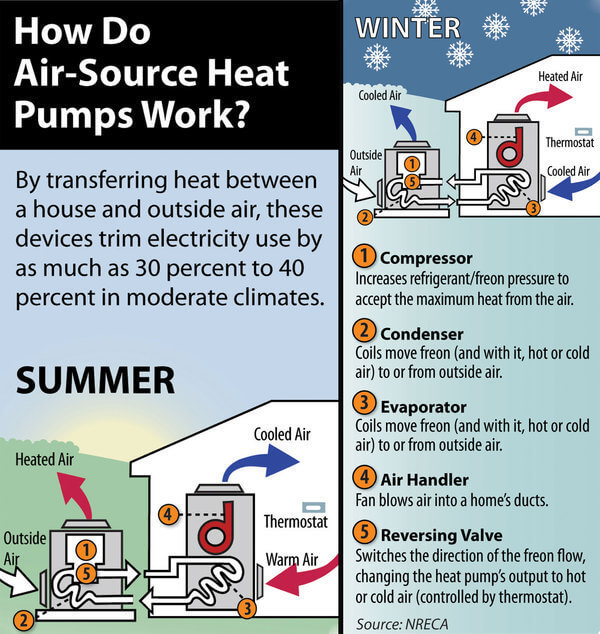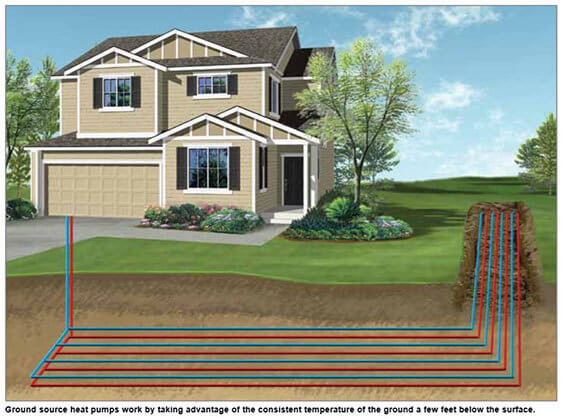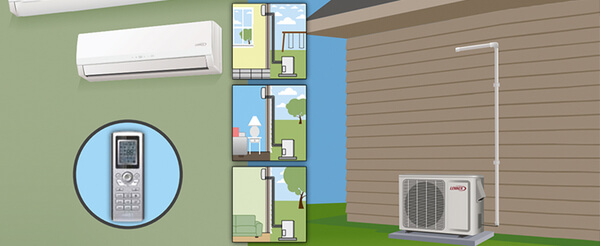Heat Pump Rebates
Install a high-efficiency electric-heating system and receive incentives from Southeastern. See some examples below:
- Ground Source Heat Pump – $800
- Air to Air Heat Pump – $600
- Mini-Split Ductless Heat Pump – $300
Requirements For Receiving Rebates & Special Rate.
Electric Heat must be the primary heating source and each structure is limited to one rebate. All necessary equipment must be installed and in operating condition before a rebate can be issued. Only one rebate per an account can be applied for in a 10 year period. Contact the Member Services Dept. for more information.
Special Note: Modular homes and or Trailer houses must be on permanent foundations or have basements in order to qualify for any said rebates. Visual inspection is needed before any rebates are issued.
Tax Credits For Geothermal
26% tax credit if system installed between Jan. 1, 2020 – Dec. 31, 2022
22% tax credit if system installed between Jan. 1, 2022- Dec. 31, 2023
TAX CREDITS FOR AIR-TO-AIR HEAT PUMPS
Existing home & principal residence. New construction & rentals do NOT apply.
10% tax credit if system is installed between Jan. 1, 2020 – Dec. 31, 2021
Heat Pump Rebate Registration Form
Rebate form is also available in a PDF version to print. Download.
"*" indicates required fields
Standard Air Conditioning vs Air Source Heat Pumps
Heat Pumps Can Save You $$$$
Have you ever wondered how standard air conditioning compares to air source heat pumps?
Air conditioners have been a cooling standard for many years and continue to be the cooling method of choice. Over the past few years, air conditioners have improved dramatically through increases in SEER ratings. SEER stands for “Seasonal Energy Efficiency Ratio” and is a rating that identifies the air conditioner’s efficiency. The higher the rating is, the better the efficiency of the unit. SEER ratings generally range from 14 to 18 SEER.
In our region of the nation, air conditioning units are typically used three months out of the year: June, July and August. On occasion, air conditioners are used in May and September. In other words, you could say that an air conditioner is typically used for three months of operation and nine months of hibernation. If you are like me, I like to get all of my money’s worth out of an air conditioner.
Air source heat pumps (ASHP) are an energy-efficient alternative to air conditioners, even in South Dakota’s colder climates. They’re an attractive option because the ASHP is capable of providing efficient cooling along with heating.
ASHPs transfer heat from outside a building to inside a building, or vice versa, and use a refrigerant system involving a compressor and a condenser to absorb heat at one place and release it at another. That definition may be a mouthful, but in simple terms, an ASHP acts like an air conditioner in the summer and is a source of heat in the winter.
So, how does an ASHP work? It uses electricity to transfer energy between indoor and outdoor air. In cooling mode, heat pumps function like an air conditioner, moving heat from inside to outside the home. In heating mode, the ASHP uses a reversing valve to reverse the flow of refrigerant to extract low-temperature heat from outdoors and deliver concentrated high-temperature heat to the home.
About 60 percent of a typical winter in South Dakota is above 20 degrees Fahrenheit, which allows the ASHP to provide you with two thirds of the heating during the season. When properly installed, an ASHP can deliver up to three times more heat energy to a home than the electrical energy it consumes.

Because of today’s technology in ASHPs, many models continue to be energy efficient even when the temperature starts to drop below 20 degrees. One thing to keep in mind is when the temperature reaches a certain point , the ASHP will not be as efficient and you may need a supplemental source of heat to maintain the temperature. In the end, ASHPs can help lower your fuel bills, especially if you are replacing older, inefficient systems. They are easy to install and require little maintenance, and with a rebate of $600 from Southeastern Electric, you can save even more. You can also put the ASHP on our special heat rate at $0.59/ kWh.
Geothermal or Ground Source Heat Pumps
How Does a Ground Source Heat Pump work?
Along with being one of the most efficient systems available to meet homeowners’ heating and cooling needs, Southeastern offers additional discounts for Ground Source Heat Pumps (GSHP) through our Electric Heat Program and we offer rebates on GSHPs up to $800.
A GSHP is the highest efficiency heating and cooling system available because it uses a renewable energy source: the earth. This system is three times more efficient than the highest efficiency gas furnace and consists of a network of durable plastic coils buried in the ground that absorb the earth’s heat energy.
A heat pump, which is connected to the coils, extracts that energy and converts it into heat, which is then transferred into the home. At the flip of a switch, the process can be reversed to cool in the summer. GSHPs are long-lasting, low-maintenance systems designed to meet 100 percent of a home’s heating and cooling needs. However, it is up to you to find and commission your own contractor for purchasing or installing a GSHP. Southeastern does not sell or install them.

Program Details:
- Receive an energy rate of $.059/kWh for the electricity your GSHP uses.
- Receive an $800 rebate on an approved GSHP system.
- The GSHP must be capable of providing the entire space heating and cooling requirements of the home.
- Special metering equipment will need to be located outside the home.
What is a Mini-Split Heat Pump System
Is a Ductless Air Source Mini-Split System Right For Me?
Mini-Split systems are becoming more popular, but are they worth the money? Learn how they work and all the info on these small units to make the decision yourself.
(Note: Systems under 2 tons can qualify for a $300 rebate but must meet DOE standard HSPF efficiency.)
Mini-split, or ductless, air conditioning/heat pump units are gaining popularity, thanks to their energy efficiency and potential to create a range of temperature zones within the same home. While they can get expensive, they’re easy to retrofit into homes without HVAC ductwork. But are these the best units for your home?
If you’re trying to choose between a mini-split system and a traditional HVAC system, you need to know what a mini-split system is and how it works. For some homeowners, a mini-split system can be the better choice – it can allow you to downsize while remaining in your home, for example, or keep family members from fighting over the thermostat. Plus, most Mini-Split systems are also Heat Pumps. So they can also help heat your home. Here’s what you need to know.
How Does a Mini-Split System Work?
In a traditional HVAC system, a unit outside your home cools air and distributes it through your home via your ductwork. But a mini-split system doesn’t rely on ductwork to supply your home with cold or hot air. Instead, refrigerant moves through insulated lines from the outdoor unit to indoor units located in each of your home’s cooling zones. Some outdoor units are powerful enough to divide your home into as many as nine cooling zones, each cooled or heated by its own separate unit. Each indoor unit cools or heats the room or zone it’s in.
Mini-Split units are more secure than window A/C units because they require only a small hole to be drilled into the wall to run the refrigerant lines through, so there’s no need to cut a huge hole in the wall and there’s no possibility that a burglar could just yank the unit out of the window and crawl inside. But mini-splits can be more expensive than traditional HVAC systems – a single-zone system can start at about $3,000, while a four-zone system can cost at least $12,000. The more zones you want, the higher the cost.

Pros and Cons of a Mini-Split System
Mini-split units don’t require ductwork, which makes them a good option for installation in homes that don’t have ductwork, because adding ducts can significantly increase the cost of installing a traditional HVAC. Mini-splits are also good for installing climate control in additions, mother-in-law units or shops/garages.
These aren’t the only benefits of a mini-split system. These systems are about 25 to 30 percent more efficient than a traditional systems because nothing is lost to the ductwork itself. Mini-splits also have inverter-driven compressors, which don’t turn on and off constantly. Instead, they speed up or slow down based on system requirements. This makes the system even more efficient than a traditional system, which loses a lot of energy in starting up a compressor repeatedly.
Mini-splits are popular with homeowners who want more precise control over the temperature of individual rooms in their homes. Each unit can be individually adjusted, so you’ll be able to call a truce in the Thermostat Wars. If you have rooms in your home that you aren’t using, a mini-split unit can help regulate the temperature in the rooms you are using, while keeping the whole-house thermostat at a higher or lower temperature. This prevents mold and other problems that can arise from merely closing the vents in unused rooms and it could possibly save you money on heating or cooling bills.
The drawbacks of a mini-split system could include their installation price if you are wanting to install for whole house cooling and heating. In this case it could be more expensive than for a traditional system if you already have the ducting. Also, you might not love the look of the wall unit in every room, although there are floor and recessed ceiling models that look more like your traditional in house venting. Other disadvantages are, the need to clean the filter every month and more often if you have pets – the fans in mini-splits can’t handle dirty filters, so falling behind on monthly maintenance can shorten the life of your unit, plus, you’ll still need to have a yearly inspection from a licensed HVAC professional who will check your unit’s refrigerant pressure and flush the condensate lines, among other things.
There are a few other possible disadvantages to consider when installing a mini-split system, although, these are rarely insurmountable. For example, you’ll need to find a suitable outdoor location for the condenser. This may be easier in some places than others.
One key issue, however, may be important if you live in an especially cold climate: (like South Dakota) in those areas where the temperature regularly dips below freezing, a mini-split system may not have the capabilities to sufficiently heat the home so you will need a supplemental heating system, such as using a gas or electric furnace, electric resistance (baseboard/cove) heat or a wood/pellet or corn stoves.
Conclusion
If you already have a traditional HVAC system, it may be cheaper to just go ahead and get another one. But if you have a home that doesn’t have ductwork, or you’re looking to cool a specific room or rooms, a mini-split system may be the best choice. It can give you more precise control over the temperature in individual rooms in your home or shop and slash your energy bills, although it may not pay for itself, it may be worth the comfort it brings.
